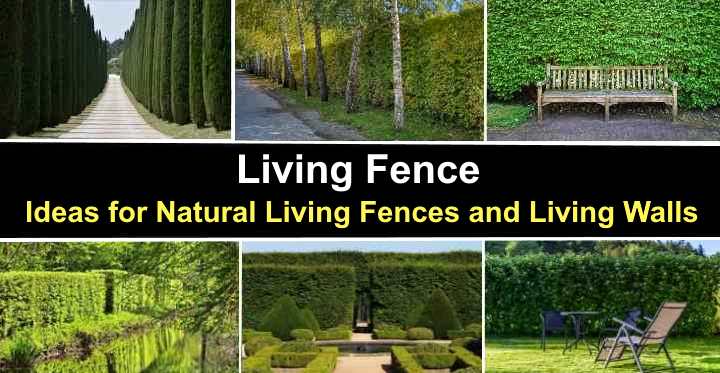In your front or backyard, a living fence is an excellent way to create a natural privacy screen, hedge, or windbreak. Planting and maintaining a living fence is less time-consuming and cost-effective than setting up wooden or chain-link barriers in the vast majority of circumstances. For creating a lovely living wall that complements your garden landscape, choose evergreen bushy trees and shrubs.
Growing a living fence provides more than just aesthetic value to your garden. Bushy shrubs provide natural privacy fencing that is more attractive than wooden or chain-link fencing and improves soil structure. Living fences are more environmentally friendly and may last longer than built fences.
The finest shrubs and trees for creating a living fence are discussed in this article. Choosing the best type of evergreen trees or shrubs for planting in your garden will be aided by descriptions and photos of hedging plants.
What Is a Living Fence?
A row of bushy shrubs or trees growing close together is commonly referred to as a living fence. A dense green natural screen is created by the deciduous or evergreen foliage. Separate boundaries, boost security, offer shelter, or enhance a garden’s appearance with attractive and functional landscaping solutions such as living fences.
The Benefits of Living Fence

Living fences enhance your garden landscape, offer all of the capabilities of a brick wall or wooden fence, and are much more attractive. Apart from light annual pruning, there is little upkeep required once a natural screen is established. A natural living fence has the following additional benefits:
The cost of maintaining a living barrier is minimal. Hedge plants are less expensive than purchasing fencing panels, bricks, or posts. Furthermore, compared to wooden or chain-link barriers, living walls are more durable. Natural green fences are low-maintenance, which is another benefit. Built fencing may be replaced by living fences for a longer time. And, to keep the evergreen barrier looking fresh, you never have to paint them.
Biodiversity is promoted and the soil structure is improved by using trees and shrubs to form a natural living wall. Several beneficial insects, animals, and birds seek shelter and food in hedgerows. A windbreak can be created by a living privacy fence.
A tall, robust privacy screen is created by planting tall evergreen conifers closely together. The natural windbreak might be many feet tall, depending on the privacy tree variety. If building constraints limit the height of built walls or wooden fences, growing a tall living barrier has benefits. The size of privacy trees is usually unlimited.
The Disadvantages of a Living Fence
For all gardens, living fences are not always the best option. The extra care required to take care of a natural screen is something to consider if you want a lawn that requires no maintenance. The concern of the death of a living fence is the most pressing.
You’ll have a gaping hole in your screen if a hedging shrub in the fence contracts a disease. Hedge plants also need a long period of time to grow to the required height. It’s crucial to choose the finest species of shrub or tree for your requirements before establishing a natural fence. Several hedge plants thrive quickly and need little upkeep to keep them looking good.
Ideas for Creating Living Walls

When designing a living fence, you have two choices: shrubs or trees. Evergreen trees are an excellent choice for bigger garden landscapes. The purpose of conceiving a natural growing wall is to supply thick foliage when and where you want it in your garden landscape.
If you have a small yard, shrubs make excellent living walls. Bushy plants average 3 to 6 feet (1.8 to 1.8 meters) in height. Several evergreen bushes are ideal for building a living wall that stays green all year long if you need to landscape a tiny garden.
Consider the light requirements, USDA growing zone, and watering needs when choosing appropriate shrubs for your living fence. Planting tall evergreen trees is another suggestion for a living fence. Tall hedge trees, especially in bigger garden landscapes, may act as a natural windbreak.
For a short, evergreen privacy screen, you can also grow conifers. To keep their height under control, however, you’ll have to trim them often.
Living Fence: The Best Trees For Growing a Natural Living Fence
Let’s look at trees that are suited for creating a living fence in further detail and imagery.
Arborvitae (Thuja) Trees for Privacy Living Fences
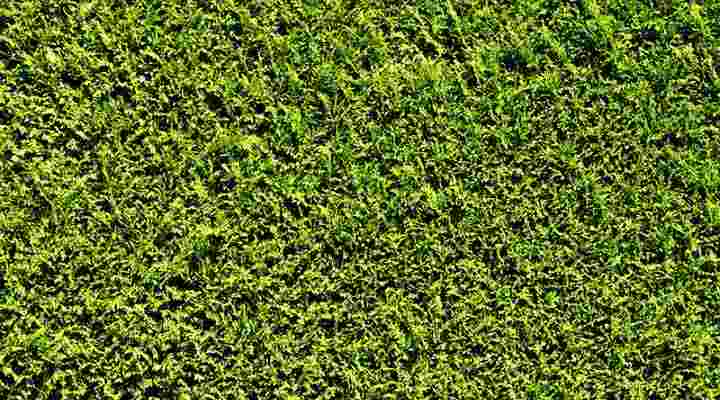
Arborvitae (Thuja) species are fast-growing evergreen trees and shrubs that make ideal living privacy fences, with numerous cultivars to choose from. Their feathery foliage, which is dense and soft, provides excellent screening, windbreaks, and natural barriers. American arborvitae (Thuja occidentalis) and Giant arborvitae (Thuja plicata) are the two most commonly used species for living fences.

Arborvitae, such as the Thuja ‘Green Giant,’ is a fast growing living privacy fence option. Shrub borders, privacy hedges, screens, and living walls are all created by planting evergreen trees together in rows. Arborvitae trees are also hardy, which is another benefit of their living fences.
They may be cultivated in USDA growing zones 2 through 7. As a natural privacy fence, here are some of the finest arborvitae species to grow:
American arborvitae (Thuja occidentalis)—Dark green, soft, scale-like needle leaves characterize this quick-growing landscaping plant. Because American arborvitae grows to be between 20 and 40 feet (2 and 12 meters) tall, it’s ideal for use as a windbreak in large-yard landscaping. Only trimming is required to keep the columnar tree’s height, which has a natural pyramidal form.

A popular tree for a living fence or privacy screen is the columnar tall Thuja occidentalis.
Arborvitae ‘Emerald Green’ (Thuja occidentalis ‘Smaragd’)—This dwarf evergreen tree is ideal for use as a hedge in small or large gardens, and it has a hedging tree shape. A slow-growing conifer that grows between 12 and 14 feet (3.6 and 4.2 meters) tall, the ‘Smaragd’ evergreen arborvitae cultivar is a great choice for privacy. The compact, upright growth of the tree and its sprays of brilliant-green glossy leaves distinguish it.

The thuja tree (also known as the ‘Smaragd’) is renowned for its privacy-attracting properties.
Baby giant arborvitae tree (Thuja plicata x standishii ‘Virginian’)—The dwarf arborvitae ‘Virginian’ is a fast-growing evergreen tree with a conical shape that is a cultivar of the popular ‘Green Giant’ arborvitae. It’s ideal as a living fence in most yard sizes, thanks to its brief growth of up to 15 feet (4.5 meters) and dense foliage.
Leyland Cypress (Cupressus x leylandii)

The Leyland cypress is a popular hedging tree for a living fence because of its fast growth and thick foliage. It is frequently utilized as a privacy screen throughout the year. A natural windbreak is best grown by planting Leyland cypress trees in rows. Unless you prune it regularly, the Leyland cypress, being a tall conifer, grows to be 50 feet (15 meters) tall.
In USDA zones 6 through 10, you may plant a Leyland cypress living fence. This popular hedging tree is trimmed to 10 to 15 feet (3–4.4 meters) tall by the majority of people who grow it.
Hicks Yew (Taxus x media ‘Hicksii’)

Hicks yew is a bushy tree that may be pruned to develop a stunning, thick living barrier for privacy from neighbors. This slow-growing conifer is ideal for small to medium garden settings because of its compact development. As they age, the yew trees take on a narrow, columnar form.
Formal hedges, foundation plantings, and privacy screens are all ideal uses for Hicks yew. In USDA zones 4 to 7, a Hicks yew grows between 12 and 20 feet (3.6 to 6 meters) tall. Creating a box hedge shape is simple with a Hicks yew hedge. As a hedgerow or topiary, this popular landscaping tree is wonderful.
Spartan Juniper (Juniperus chinensis ‘Spartan’)

The juniper cultivar ‘Spartan’ is an attractive, fast-growing, bushy columnar evergreen that is commonly used for landscaping for privacy. As a formal hedge plant, the ‘Spartan’ juniper is excellent. In USDA zones 4 to 9, the dark green, velvety needle-like leaves create a privacy and defense screen.
It can grow up to 20 feet (6 meters) tall. The spreading growth of the juniper cultivar makes it ideal for hedge or natural windbreak formation.
Brodie Eastern Red Cedar (Juniperus virginiana ‘Brodie’)

The false cedar species known as the “Brodie” is a drought-tolerant tall tree that can be used to screen neighbors out. During the winter, the delicate scale-like decorative leaves stay green. The eastern red cedar, commonly known as the Brodie, is a low-maintenance hedging tree that may be used to create a formal living fence or a large-scale privacy screen.
The Brodie Eastern Red Cedar grows to be 15 to 20 feet (4.5 to 6 meters) tall and 7 feet (2 meters) broad. To create an evergreen border hedge, plant in full sun in USDA zones 3 to 8.
Moonglow Juniper Hedging Tree (Juniperus scopulorum ‘Moonglow’)

The ornamental silvery-blue living fence created by planting moonglow juniper hedge trees is similar to that of many other juniper trees. The dazzling silvery-blue foliage of the Moonglow juniper tree is a appealing characteristic. As the trees are grown close together, its dense growth habit creates a protective living fence.
The USDA zones 3 through 7 ‘Moonglow’ juniper trees are also ideal windbreaks because of their height. It may grow to be 6 feet (1.8 meters) wide and grows between 15 and 20 feet (4.5 meters). If you want a magnificent silvery living barrier for privacy, cover, or noise prevention, grow the ‘Moonglow’ juniper.
Canadian Hemlock (Tsuga canadensis)

The Canadian hemlock is a big coniferous tree that is ideal for creating a tall privacy living barrier. It grows quickly and densely. Flat sprays with short green needle-like leaves make up the evergreen foliage. The conical form and arching branches of the hemlock species make it stand out.
The Canadian hemlock is a pleasant living barrier, screen, or hedge that grows in a row. The eastern hemlock is another name for this hemlock tree. The tall hedge tree may grow up to 35 feet (10 meters) broad and reach a height of 40 to 70 feet (12–21 meters). In USDA zones 3 to 7, the cone-producing tree thrives in partial to full shade.
Shrubs for Living Privacy Fence
Let’s explore shrub species that are suited for making a living barrier based on their descriptions and pictures.
Photinia ‘Red Robin’ (Photinia x fraseri ‘Red Robin’)

This broadleaf, evergreen shrub with its bushy growth is ideal for a medium-sized living fence. Grow Photinia ‘Red Robin’ living privacy fence for its lovely red foliage. The vivid scarlet new leaves that appear in the spring inspired the cultivar name. In late April, the hedging shrub produces 5-petaled white flowers and has glossy, leathery, dark green oval leaves.
Compact shrubs such as the photinia shrub ‘Red Robin,’ suitable for privacy screens, natural, informal borders, and hedgerows. In USDA zones 7 through 9, in full sun and loamy, well-drained soil, you can grow a colorful photinia living fence. At 9 to 12 feet (2.7 – 3.6 meters) tall, the hedging shrub matures.
Cherry Laurel (Prunus laurocerasus)

If you want a year-long privacy hedge, choose cherry laurel, which is a fast growing evergreen shrub. The glossy green leaves of the cherry laurel plant are highly dense and spread out extensively, making it an standout plant. Cherry laurel’s lovely white spring blooms are another reason it’s a popular living fence shrub.
This decorative evergreen hedge plant grows in USDA zones 6 through 8 and is commonly called English laurel. The privacy fence thrives in full sun, but can handle considerable shade. It can grow to be 10 feet (3 meters) tall and broad. If you have a shade garden and need to build a natural barrier or protective screen, cherry laurel is worth considering as a green living fence.
Boxwood Hedge Plant (Buxus sempervirens)
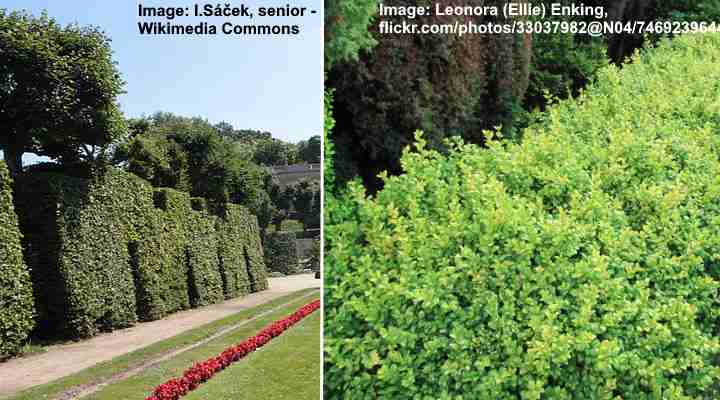
Boxwood shrubs are excellent for creating a natural living fence since they’re simple to form and prune. Little glossy oval leaves and thickly growing branches make up the evergreen foliage. For little border hedgerows or huge privacy screens, you can establish boxwood living fences.
Buxus plants are readily pruned and shaped, which accounts for the popular name. You might prune the shrubby plants into different forms or build a formal living fence in a box form. Here are some suitable boxwood bushes for a living barrier:
Japanese boxwood ‘Green Beauty’ (Buxus microphylla var. japonica)—The lush, dense foliage and rounded growth habit of the ‘Green Beauty’ hedging shrub make it popular. The plant grows up to 5 feet (1.5 meters) tall and thrives in USDA zones 6 to 9 and partial shade. As a low-growing hedge, formal green fence, or natural security screen, it’s ideal.

Buxus microphylla variety microphylla For a low living fence or small gardens, japonica is a good option.
Boxwood Dee Runk (Buxus sempervirens ‘Dee Runk’)—This tall boxwood cultivar, which grows between 7 and 8 feet (2.4 to 2.4 meters) tall, creates an all-year living barrier.

Dee Runk’s meticulously designed living fence is formed by boxwood’s lovely columnar growth.
Boxwood ‘Winter Gem’ (Buxus microphylla ‘Winter Gem’)—Planting as a medium-sized living privacy screen is perfect for the ‘Winter Gem’ boxwood cultivar. The 4 ft. (1.2 m) tall densely growing shrub has a rounded growth. In formal gardens or front or backyards, this small shrub is ideal for hedging and natural screens. USDA zone 5-9.

For a tough, low-maintenance living barrier, plant Buxus Winter Gem.
Holly Bushes for Living Privacy Fence (Ilex)

Because of their dense growth and spiky foliage, Holly bushes are a popular low-maintenance option for security screens or privacy hedges in your front or back yard. Beautiful, low-maintenance hedgerows are created by thorny, evergreen shrubs with their glossy leaves. Here are a few good candidates for holly bushes that you may use as living barriers:
Alaska Holly (Ilex aquifolium ‘Alaska’)—The prickly leaves on the holly tree ‘Alaska’ protect your property from unwelcome visitors. The bushy shrub grows to be 16 feet (5 meters) tall and has a slender growth. USDA zones 5 to 9 are suitable for this plant.

The coldest and most attractive of all hollies, Alaska holly is a tough living fence plant.
Dragon Lady Holly (Ilex × aquipernyi ‘Meschick’)—Smooth, lustrous green leaves and thick foliage distinguish the holly shrub Dragon Lady. It’s best used as a living fence or privacy screen because of its columnar shape. In USDA zones 6 to 9, it grows 10 to 20 feet (3 – 6 meters) tall.
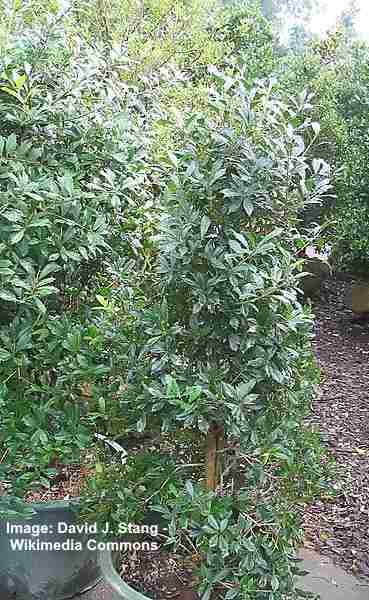
These plants are wonderful for concealing and forming a boundary hedge.
Sky Pencil Holly (Ilex crenata ‘Sky Pencil’)—Narrow, upright growth and glossy green leaves characterize the ‘Sky Pencil’ holly shrub. This holly cultivar is suited for building a living barrier for a front or rear yard and grows to be 6 to 10 feet (1.8 to 3 meters) tall.
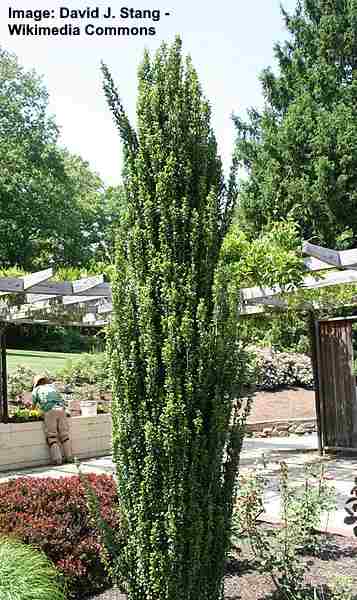
Sky Pencil Holly is a short, modestly growing tree.
Californian Privet (Ligustrum ovalifolium)
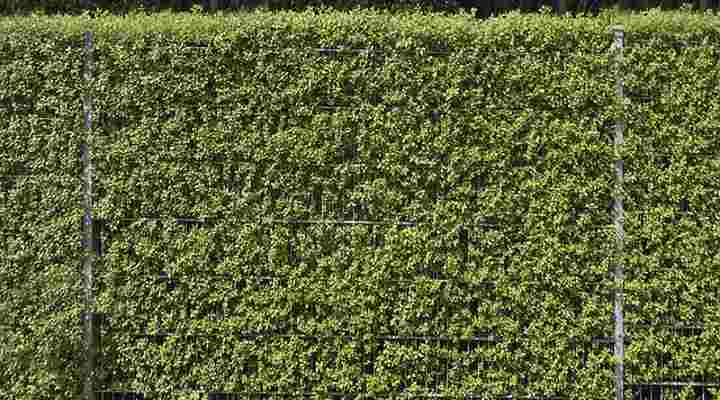
If you want a fast-growing privacy hedge or living fence, choose privet shrubs. The broadleaved shrub grows to be about 15 feet (4.5 meters) tall and broad, growing up to 15 feet (4.5 meters) wide. The dark-green, glossy ovate leaves make up the thick foliage.
The hedge blooms fragrance white flowers in the summer. In USDA zones 7 to 10, the Californian privet is an evergreen hedge. The native ornamental fence, which drops its leaves in the autumn in colder zones, is deciduous.
Japanese Spindle Living Fence (Euonymus japonicus)
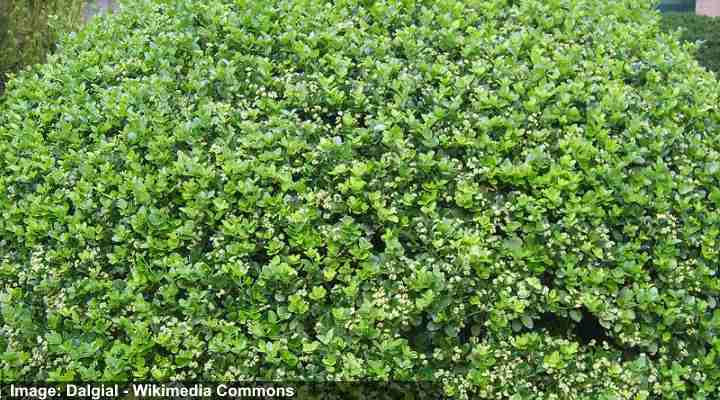
This little evergreen shrub is an fantastic hedging plant for small-scale landscaping. It is grown in dense bush fence of Japanese spindle, also known as Box-Leaf Euonymus and Evergreen Euonymus. The glossy, leathery green leaves of the Japanese spindle shrub Japanese spindle plants thrive in full sun and shade as a versatile plant for living fences.
Variegated, bright yellow and green leaves create a spectacular colorful bushy living fence in some exceptional Euonymus japonicus cultivars. In USDA zones 6 through 9, the Japanese spindle may grow to 15 feet (4.5 meters) tall and cold hardy.
Japanese Pittosporum (Pittosporum tobira)

The Japanese Pittosporum is a fast-growing evergreen shrub that makes for a living fence. Up to 13 feet (4 meters) tall, the deep development and tightly spreading leaves. It’s a hardy, drought-tolerant species that grows best in full sun. In USDA zones 8 through 10, Japanese Pittosporum plants perform best. In warm areas, the Japanese Pittosporum makes a excellent flowering living screen, hedge, or barrier.
Chinese Fringe Flower (Loropetalum chinense)
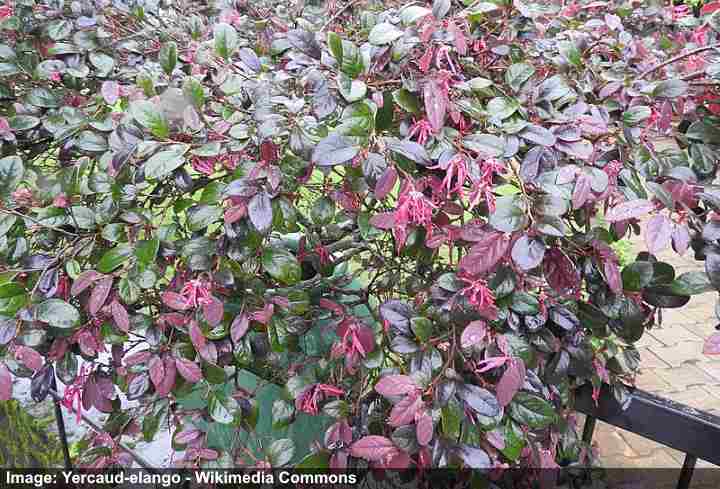
The Chinese fringe flower is an ornamental evergreen shrub that may be trimmed into a lovely colorful fence with its lovely purple foliage. The spring flowers with four spindly petals are a lovely feature of this showy living fence. 3″ (7.5 cm) long fuzzy ovate green and purple leaves Between 6 and 10 feet (1.8 and 3 meters) long, the bushy privacy fence plant grows.
As a natural privacy screen or colorful hedgerow, grow the Chinese fringe flower to provide your yard protection from the wind. USDA zones 7 to 9 are recommended for growing.
